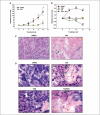Cross-talk between notch and the estrogen receptor in breast cancer suggests novel therapeutic approaches
- PMID: 18593923
- PMCID: PMC4445363
- DOI: 10.1158/0008-5472.CAN-07-5744
Cross-talk between notch and the estrogen receptor in breast cancer suggests novel therapeutic approaches
Erratum in
- Cancer Res. 2008 Sep 1;68(17):7246. Song, Lynda L [added]
Abstract
High expression of Notch-1 and Jagged-1 mRNA correlates with poor prognosis in breast cancer. Elucidating the cross-talk between Notch and other major breast cancer pathways is necessary to determine which patients may benefit from Notch inhibitors, which agents should be combined with them, and which biomarkers indicate Notch activity in vivo. We explored expression of Notch receptors and ligands in clinical specimens, as well as activity, regulation, and effectors of Notch signaling using cell lines and xenografts. Ductal and lobular carcinomas commonly expressed Notch-1, Notch-4, and Jagged-1 at variable levels. However, in breast cancer cell lines, Notch-induced transcriptional activity did not correlate with Notch receptor levels and was highest in estrogen receptor alpha-negative (ERalpha(-)), Her2/Neu nonoverexpressing cells. In ERalpha(+) cells, estradiol inhibited Notch activity and Notch-1(IC) nuclear levels and affected Notch-1 cellular distribution. Tamoxifen and raloxifene blocked this effect, reactivating Notch. Notch-1 induced Notch-4. Notch-4 expression in clinical specimens correlated with proliferation (Ki67). In MDA-MB231 (ERalpha(-)) cells, Notch-1 knockdown or gamma-secretase inhibition decreased cyclins A and B1, causing G(2) arrest, p53-independent induction of NOXA, and death. In T47D:A18 (ERalpha(+)) cells, the same targets were affected, and Notch inhibition potentiated the effects of tamoxifen. In vivo, gamma-secretase inhibitor treatment arrested the growth of MDA-MB231 tumors and, in combination with tamoxifen, caused regression of T47D:A18 tumors. Our data indicate that combinations of antiestrogens and Notch inhibitors may be effective in ERalpha(+) breast cancers and that Notch signaling is a potential therapeutic target in ERalpha(-) breast cancers.
Figures






References
-
- Miele L, Golde T, Osborne B. Notch signaling in cancer. Curr Mol Med. 2006;6:905–18. - PubMed
-
- Miele L. Notch signaling. Clin Cancer Res. 2006;12:1074–9. - PubMed
-
- Roy M, Pear WS, Aster JC. The multifaceted role of Notch in cancer. Curr Opin Genet Dev. 2007;17:52–9. - PubMed
-
- Weng AP, Ferrando AA, Lee W, et al. Activating mutations of NOTCH1 in human T cell acute lymphoblastic leukemia. Science. 2004;306:269–71. - PubMed
-
- Malyukova A, Dohda T, von der LN, et al. The tumor suppressor gene hCDC4 is frequently mutated in human T-cell acute lymphoblastic leukemia with functional consequences for Notch signaling. Cancer Res. 2007;67:5611–6. - PubMed
Publication types
MeSH terms
Substances
Grants and funding
LinkOut - more resources
Full Text Sources
Other Literature Sources
Medical
Research Materials
Miscellaneous

